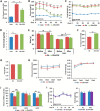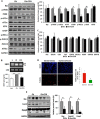Small Molecular Allosteric Activator of the Sarco/Endoplasmic Reticulum Ca2+-ATPase (SERCA) Attenuates Diabetes and Metabolic Disorders
- PMID: 26702054
- PMCID: PMC4777852
- DOI: 10.1074/jbc.M115.705012
Small Molecular Allosteric Activator of the Sarco/Endoplasmic Reticulum Ca2+-ATPase (SERCA) Attenuates Diabetes and Metabolic Disorders
Abstract
Dysregulation of endoplasmic reticulum (ER) Ca(2+) homeostasis triggers ER stress leading to the development of insulin resistance in obesity and diabetes. Impaired function of the sarco/endoplasmic reticulum Ca(2+)-ATPase (SERCA) has emerged as a major contributor to ER stress. We pharmacologically activated SERCA2b in a genetic model of insulin resistance and type 2 diabetes (ob/ob mice) with a novel allosteric activator, CDN1163, which markedly lowered fasting blood glucose, improved glucose tolerance, and ameliorated hepatosteatosis but did not alter glucose levels or body weight in lean controls. Importantly, CDN1163-treated ob/ob mice maintained euglycemia comparable with that of lean mice for >6 weeks after cessation of CDN1163 administration. CDN1163-treated ob/ob mice showed a significant reduction in adipose tissue weight with no change in lean mass, assessed by magnetic resonance imaging. They also showed an increase in energy expenditure using indirect calorimetry, which was accompanied by increased expression of uncoupling protein 1 (UCP1) and UCP3 in brown adipose tissue. CDN1163 treatment significantly reduced the hepatic expression of genes involved in gluconeogenesis and lipogenesis, attenuated ER stress response and ER stress-induced apoptosis, and improved mitochondrial biogenesis, possibly through SERCA2-mediated activation of AMP-activated protein kinase pathway. The findings suggest that SERCA2b activation may hold promise as an effective therapy for type-2 diabetes and metabolic dysfunction.
Keywords: AMP-activated kinase (AMPK); Ca2+ homeostasis; SERCA2b; diabetes; endoplasmic reticulum stress (ER stress); glucose metabolism; hepatosteatosis; insulin sensitivity; lipid metabolism; mitochondria efficiency.
© 2016 by The American Society for Biochemistry and Molecular Biology, Inc.
Figures







References
Publication types
MeSH terms
Substances
Grants and funding
- K01 DK099463/DK/NIDDK NIH HHS/United States
- R01 HL097357/HL/NHLBI NIH HHS/United States
- R01 AA023416/AA/NIAAA NIH HHS/United States
- DK020541/DK/NIDDK NIH HHS/United States
- HL097375/HL/NHLBI NIH HHS/United States
- R01 HL128072/HL/NHLBI NIH HHS/United States
- P50 AG005138/AG/NIA NIH HHS/United States
- P60 DK020541/DK/NIDDK NIH HHS/United States
- DK083658/DK/NIDDK NIH HHS/United States
- R01 DK083658/DK/NIDDK NIH HHS/United States
- R01 HL129814/HL/NHLBI NIH HHS/United States
- R01 DK111417/DK/NIDDK NIH HHS/United States
- P30 DK020541/DK/NIDDK NIH HHS/United States
- R56 DK083658/DK/NIDDK NIH HHS/United States
- R56 DK100624/DK/NIDDK NIH HHS/United States
LinkOut - more resources
Full Text Sources
Other Literature Sources
Medical
Research Materials
Miscellaneous

